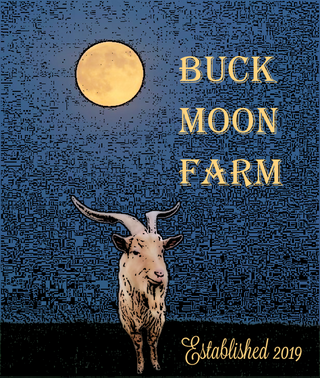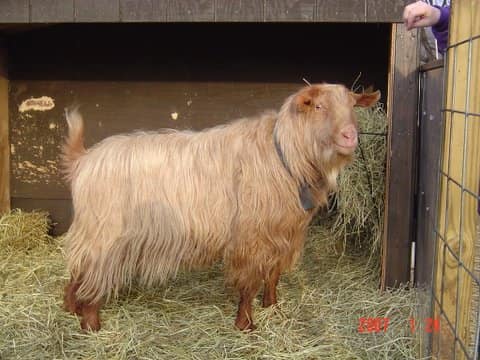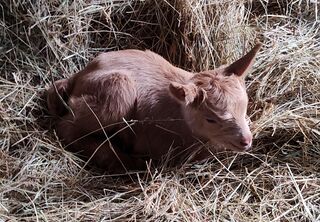History of the Guernsey Goat
The early years of Golden and British Guernseys in the UK and US
Origin
The Golden Guernsey goat originated on the Channel Islands (British Crown Dependencies) in the English Channel. These islands were ports of call for sailing ships, sailing out of the Mediterranean and headed for the Cornish tin mines since long before the birth of Christ. These ships often carried goats and other animals, trading them and acquiring others all along their routes and no doubt continued this on the Channel Islands.
Thus the ancestry of the Golden Guernsey is uncertain shrouded in mystery and antiquity, although the Guernsey goats do bear a striking resemblance to goats in the Greek islands, and are thought to have Middle Eastern origin (perhaps through the Maltese or Syrian goat) rather than Swiss origin. While the origin is unknown, DNA research by Dr. Phil Sponenberg in Cooperation with the University of Cordoba in Spain has found that Guernsey goats are genetically distinct from other European breeds, and thus indigenous to Guernsey.
Great Britain
Golden Guernsey goats were first registered in the general herd book of the Guernsey Goat Society beginning in 1922. In 1924 Miss Miriam Milbourne took an interest in the golden goats among the scrub herds on Guernsey, and began keeping goats in 1937, and managed to retain her herd through the German occupation. In the early 1950s she developed a specific breeding program for the Golden Guernsey goat at the suggestion of Dr. Tracey, a BGS judge. Because of her efforts, a Golden Guernsey registry was opened in the Guernsey Goat Society’s herd book in 1965.
Golden Guernseys were imported into England in 1967, and the British Goat Society Golden Guernsey register was opened in 1971. The Golden Guernsey goat breed (the Guernsey Goat’s parent breed) is a rare breed, listed with the Rare Breeds Trust, and currently recognized by the British Goat Society and the Golden Guernsey Goat Society of the United Kingdom. The Guernsey Goats in the United States are currently registered with the BGS, the Guernsey Goat Breeders of America, and the American Guernsey Goat Registry.
It is clear that the ancestry using the Golden Guernsey, as the parent breed, results in the Guernsey Goat being unique among the dairy goats of North America and brings to ADGA its heritage of hardiness and the ability to efficiently produce large volumes of milk with strong component numbers.
United States
Currently the United States Department of Agriculture (USDA) regulations do not permit the import of live goats from any country in Europe. As a result, all imports of Guernsey genetics involved frozen embryos or semen. Guernsey goats were introduced to the United States from Great Britain in the late 1990s. The first introduction of Guernsey genetics was via embryos imported into Canada in 1996.
The embryos were collected, stored, and shipped on Ministry Approved Premises by Edinburgh Genetics, now known as Innovis Ltd. (http://www.innovis.org.uk/). These embryos were implanted into Spanish does that were subsequently imported into the U.S. under USDA regulations. The embryo recipients kidded in the spring of 1998. Eight of the ET kids survived to adulthood. Scawton Hadrian was the sire of all surviving kids.
Embryo donor 1: Cykewell Chive produced Swind Copper (M).
Embryo donor 2: Scawton Pixie produced Swind StPatrick (M), Swind Patch (M), Swind Pixie (F), and Swind Platinum (M). Platinum sired no offspring due to urinary calculi.
Embryo donor 3: Peaclond Progress produced Swind Princess (F), Swind Penny (F), and Swind Peach (F).
All Golden Guernseys in the United States are descended from these 8 animals.The subsequent importations of Guernsey genetics all consisted of semen shipments as the ability to import embryos from the UK via Canada was no longer permitted by existing regulations.The first semen import was received in 1997 by Dr. Dennis Gourley, Elite Genetics, Canada. That business has gone defunct, so we are unable to get original records from him. Goldicroft Peter and Janig Major were collected by Innovis Ltd, and following receipt, the semen was delivered to Linda Campbell of Khimaira Farm. Linda served as the distributor of the semen.
Currently there are offspring of Goldicroft Peter and Janig Major registered to Diane Grey’s Bluecollar Herd. There is one daughter of Goldcroft Peter registered to the Southwind (Swind) herd. There are no other registered offspring of these two bucks currently in the United States.The second semen import was also collected by Innovis Ltd. It consisted exclusively of semen from Crimea Pembroke and was shipped to the New York airport for Mr. Skolnick, deceased, owner of the Southwind Herd. Additional information has been requested from Mr. Skolnick’s herd manager, Laura Burnside.
The third semen import was received in 2003 and included semen from Peaclond Pureglow and Crimea Pembroke collected by Innovis Ltd. It was exported with ram semen to Martin Dally at University of California Davis, and picked up by Kathy Noble. Dr. Dally is now located in Oregon with Super Sire Ltd. (http://www.toprams.com/).The fourth semen shipment included semen from the bucks Peaclond Puregleam, and Aureum Alinus, all collected by Innovis Ltd. They were exported with ram semen to Martin Dally at University of California Davis.
The shipment was picked up by Nina Schafer. Dr. Dally is now located in Oregon with Super Sire Ltd. (http://www.toprams.com/) and has generously provided the GGBoA with copies of the import documents for both the third and fourth shipments. Those documents are included in the Appendix.The Southwind Herd was released from USDA quarantine in 2002. Following this they offered semen from the Golden Guernsey bucks for sale. The first Golden Guernsey buck sold in the U.S. was Swind Panzer. Panzer became senior herdsire for Joan Stump’s Stumphollo herd in 2002.
Following Panzer several other Swind bucks were sold to breeders around the United States. Swind bucks that made a significant impact on Guernsey breeding up programs include: Swind Copper (semen only), Swind Dante, Swind Paladin, Swind Panzer, Swind Paris, Swind Pauper, Swind Pence, Swind Pendragon, Swind Plymouth, Swind Prince, Swind Rockafella, Swind Xavier, and Swind Xqsme.
The first Guernsey cross does produced through imported semen were born in Diane Grey’s Bluecollar Herd in 1999. These does were produced through breeding an Oberhasli doe (Bluecollar Blinken) to Goldicroft Peter A.I. In subsequent years Diane had very good success with A.I., producing another nine does using imported semen and many more with domestic semen.The first American Guernsey doe, Bluecollar Yellowbird (HB) was born in Diane Grey’s Bluecollar Herd in 2003. The first American Guernsey buck, Bluecollar Juancanary (HB2) was born in 2004.
The first British Guernseys were born in Diane Grey’s Bluecollar Herd in 2006. American Guernsey (HB) does were registered in other herds beginning in 2006 (Ann, Becki, and Jodi Blackwell’s “Golden Goodness”, Kate Posey’s “Snowbird”, and Joan Stump’s “Stump*Hollow”), and the first American Guernsey (HB2) bucks were registered in other herds (Betsy Hultin’s “Glastonbury”, and Joan Stump’s “Stump*Hollow”) in 2009. Once HB2 (American) and British Guernsey bucks became available, Guernsey breeding rapidly expanded in the United States.
July 20, 2023


